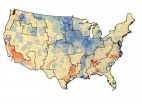(Press-News.org) In the months after the April 16, 2007, shootings at Virginia Tech, two professors administered a survey to assess posttraumatic stress among students. The findings have been published in the July 18, 2011 issue of the Journal of Psychological Trauma: Theory, Research, Practice, and Policy, published by the American Psychological Association.
According to researchers Michael Hughes, professor of sociology in the College of Liberal Arts and Human Sciences, and Russell T. Jones, professor of psychology in the College of Science, 15.4 percent of Virginia Tech students experienced high levels of posttraumatic stress three to four months following the shootings in which 49 students and faculty members at the university were shot, 32 of whom were killed.
These findings were from a web-based survey of students that was conducted during the summer and fall after the shootings. A total of 4,639 students from the population of 23,214 (20 percent) agreed to complete the survey, which included questions about exposure to the shootings and other trauma-related stressors.
Prevalence of posttraumatic stress was significantly higher among women (23.2 percent) than men (9.9 percent). "The research suggests that higher female-than-male posttraumatic stress was primarily due to greater female losses in secondary networks," Jones said. "These losses were in the form of deaths, injuries, and close calls of individuals who were not considered close friends or relatives. These findings could also be a function of other losses characterized by perceived danger or harm in the absence of information or extended periods of worry."
Exposure to trauma-related stressors varied greatly, from 4.6 percent who reported being in close proximity to the first shooting incident in Ambler-Johnston Hall to 64.5 percent unable to confirm the safety of friends. The stress exposures that were most strongly related to symptoms of posttraumatic stress were the death or injury of someone close and the inability to confirm the safety of friends during the two hours after the Norris Hall shootings. "It appears that the stressors most responsible for posttraumatic stress among Virginia Tech students had to do with social relationships – deaths and injuries involving friends and anxiety about the safety of friends," said Hughes.
Because exposure to stressors was widespread among students on campus, the experience of symptoms of posttraumatic stress was also widespread, reaching well beyond those who had direct exposure to the actual shooting incidents. These findings have important implications for planning mental health treatment outreach. Widespread symptom prevalence made it difficult to target a small, highly exposed segment of students for mental health outreach. This low concentration of probable posttraumatic stress disorder will likely be a common feature of future mass trauma incidents, requiring broad-based outreach to find students needing mental health treatment intervention.
INFORMATION:
Hughes and Jones served as co-principal investigators on this research. The article, Posttraumatic stress among students after the shootings at Virginia Tech (http://bit.ly/neKgua), was co-authored by Jones, Melissa Brymer (University of California, Los Angeles), Wai Tat Chiu (Harvard Medical School), John A. Fairbank (Duke University Medical Center), Robert S. Pynoos (University of California, Los Angeles), Virginia Rothwell (Longwood University), Alan Steinberg (University of California, Los Angeles), and Ronald C. Kessler (Harvard Medical School).
Major funding for this study was provided by an unrestricted grant from the Jed Foundation. Support was also provided through funding received by Virginia Tech from the U.S. Department of Education, Office of Safe and Drug Free Schools.
Learn more about Dr. Hughes at http://www.sociology.vt.edu/people/Hughes.html
Learn more about Dr. Jones at http://www.psyc.vt.edu/users/rtjones
Virginia Tech professors publish research on post-traumatic stress
2011-08-04
ELSE PRESS RELEASES FROM THIS DATE:
Raptor usurpers in neighboring habitats reshape the conventional wisdom
2011-08-04
When we make plans that will change a natural environment — whether it's building a new shopping mall or planting a new forest — surveyors dutifully assess the environmental risks to plant and animal life in the region. But what's environmentally good for one area may be an environmental disaster for an adjacent one, a Tel Aviv University researcher cautions.
When displaced by these projects, indigenous species migrate to neighboring habitats, says Guilad Friedemann, a PhD student at TAU's Department of Zoology in the George S. Wise Faculty of Life Sciences. This has ...
Getting to the heart of the appeal of video games
2011-08-04
People spend 3 billion hours a week playing videogames but little is known scientifically about why they are actually fun in the first place.
The vast majority of research into videogames has concentrated on the possible harmful effects of playing videogames, ignoring the simple question of why people actually want to play them.
But new research led by scientists at the University of Essex sheds some light on the appeal of videogames and why millions of people around the world find playing them so much fun.
The study investigated the idea that many people enjoy playing ...
UI biologist finds one species of pathogen can produce two distinct biofilms
2011-08-04
Many medical devices, ranging from artificial hip joints to dentures and catheters, become sites for unwelcome guests -- complex communities of microbial pathogens called biofilms that are resistant to the human immune system and antibiotics, thus proving a serious threat to human health.
However, researchers may have a new way of looking at biofilms, thanks to a study conducted by University of Iowa biologist David Soll and his colleagues published in the Aug. 2 issue of the online, open access journal PLoS Biology.
Previously, researchers believed that each pathogen ...
USDA scientists study effects of rising carbon dioxide on rangelands
2011-08-04
This press release is available in Spanish.
Rising carbon dioxide (CO2) levels can reverse the drying effects of predicted higher temperatures on semi-arid rangelands, according to a study published today in the scientific journal Nature by a team of U.S. Department of Agriculture (USDA) and university scientists.
Warmer temperatures increase water loss to the atmosphere, leading to drier soils. In contrast, higher CO2 levels cause leaf stomatal pores to partly close, lessening the amount of water vapor that escapes and the amount of water plants draw from soil. ...
Mayo Clinic examines why knee osteoarthritis afflicts more women than men
2011-08-04
JACKSONVILLE, Fla. — A Mayo Clinic orthopedic surgeon suspects that the nagging pain and inflammation that women can experience in their knees may be different from what men encounter, and she has been chosen to lead a novel U.S.-Canadian study to explore the question. The Society for Women's Health Research (SWHR) and its Interdisciplinary Studies in Sex-Differences (ISIS) Network on Musculoskeletal Health has awarded a group of researchers a $127,000 grant to lead a pilot project to understand whether biological differences between men and women affect the incidence and ...
Carbon hitches a ride from field to market
2011-08-04
RICHLAND, Wash. – Today, farming often involves transporting crops long distances so consumers from Maine to California can enjoy Midwest corn, Northwest cherries and other produce when they are out of season locally. But it isn't just the fossil fuel needed to move food that contributes to agriculture's carbon footprint.
New research published in the journal Biogeosciences provides a detailed account of how carbon naturally flows into and out of crops themselves as they grow, are harvested and are then eaten far from where they're grown. The paper shows how regions that ...
'Watermark ink' device identifies unknown liquids instantly
2011-08-04
Cambridge, Mass. - August 3, 2011 - Materials scientists and applied physicists collaborating at Harvard's School of Engineering and Applied Sciences (SEAS) have invented a new device that can instantly identify an unknown liquid.
The device, which fits in the palm of a hand and requires no power source, exploits the chemical and optical properties of precisely nanostructured materials to distinguish liquids by their surface tension.
The finding, published in the Journal of the American Chemical Society (JACS), offers a cheap, fast, and portable way to perform quality ...
UGA researchers use gold nanoparticles to diagnose flu in minutes
2011-08-04
Arriving at a rapid and accurate diagnosis is critical during flu outbreaks, but until now, physicians and public health officials have had to choose between a highly accurate yet time-consuming test or a rapid but error-prone test.
A new detection method developed at the University of Georgia and detailed in the August edition of the journal Analyst, however, offers the best of both worlds. By coating gold nanoparticles with antibodies that bind to specific strains of the flu virus and then measuring how the particles scatter laser light, the technology can detect influenza ...
GEN reports on nanotechology's impact on mass spectrometry
2011-08-04
New Rochelle, NY, August 3, 2011—A move toward smaller and smaller sample sizes is leading to a new generation of mass spectrometry instrumentation, reports Genetic Engineering & Biotechnology News (GEN). From a specific application point of view, novel nanoflow separation methodologies are ramping up the speed and precision with which scientists are able to validate biomarkers, according to the August issue of GEN (www.genengnews.com/gen-articles/nanoliter-volumes-push-ms-to-new-lows/3741).
"Basing biomarker validation on more sophisticated mass spec tools could help ...
Researchers develop and test new molecule as a delivery vehicle to image and kill brain tumors
2011-08-04
RICHMOND, Va. (Aug. 3, 2011) – A single compound with dual function – the ability to deliver a diagnostic and therapeutic agent – may one day be used to enhance the diagnosis, imaging and treatment of brain tumors, according to findings from Virginia Commonwealth University and Virginia Tech.
Glioblastomas are the most common and aggressive brain tumor in humans, with a high rate of relapse. These tumor cells often extend beyond the well-defined tumor margins making it extremely difficult for clinicians and radiologists to visualize with current imaging techniques. Researchers ...




